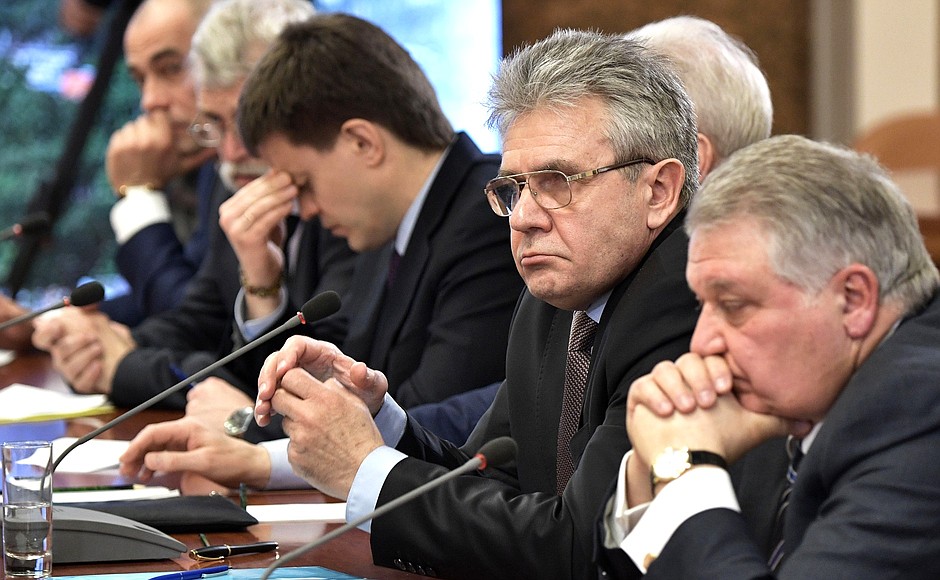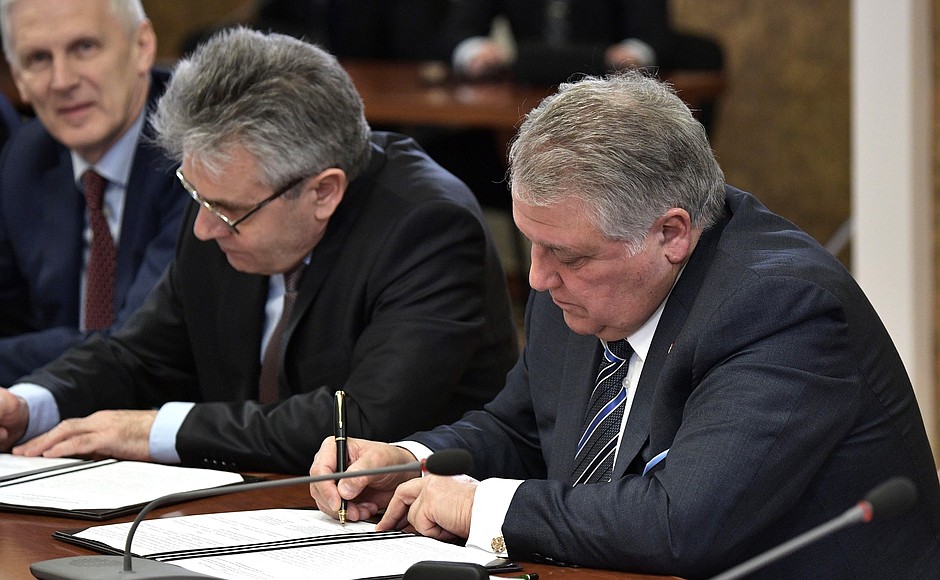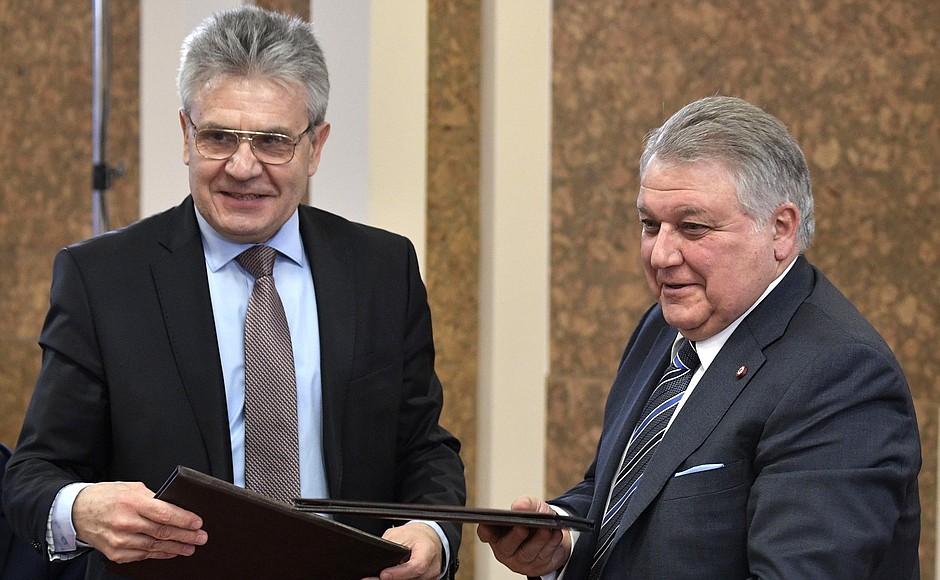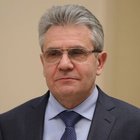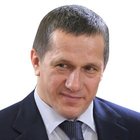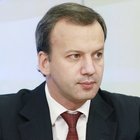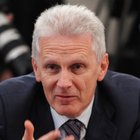President of Russia Vladimir Putin: Good afternoon, friends,
Today we are meeting at the Kurchatov Institute, a research centre with an incredible history that continues its rapid development today. We were talking about this right now, and Mikhail Kovalchuk told me about it in detail and showed me around the centre. It is necessary to have such research centres, not only in Moscow or the leading regions, but throughout Russia.
Over the past few years, we have worked hard to build up our research potential, and we have achieved noticeable success in this. We have developed a research infrastructure, including at our universities.
By creating a network of federal universities, we have strengthened not only our education system but also our research sphere as a whole. I would like to say that Igor Kurchatov, the founder of the Kurchatov Institute, graduated from Crimean Federal University, then Taurida University.
Over the past few years, we have worked hard to build up our research potential, and we have achieved noticeable success in this.
Measures to boost the development of science across Russia were outlined at the meetings of the Council for Science and Education and in the Presidential Address to the Federal Assembly. We also talked about this at a recent meeting with the President [of the Russian Academy of Sciences Alexander Sergeyev]. We decided to create mega-science centres in Novosibirsk and in Protvino in the Moscow Region.
See also
Large research centres will be established at leading universities in Kaliningrad, the Volga region, in southern Russia, in Siberia and the Far East. In fact, they are being created as we talk. They will greatly enhance our competitiveness and become centres of attraction for the best international scientists and young Russian researchers.
Not just prominent leading universities and research centres should be used as the basis for the establishment of new technology centres.
In fact, our spatial development programme, about which I also spoke in the Presidential Address, is designed to provide conditions for the people’s creative endeavours and to encourage them to form new research communities, so that conditions for self-realisation, interesting jobs and a full-bodied life will be available across Russia.
Of course, we must also continue to improve the social status of our researchers, designers and engineers, who are moving our science forward and making genuine breakthroughs.
Let us hold a general discussion on these issues. And then we will hold one more meeting.
Let’s proceed, please.
President of the Russian Academy of Sciences Alexander Sergeyev: Mr President, colleagues,
The draft law introduced by the President to amend Federal Law No. 253 grants the Russian Academy of Sciences significant additional authority. Among other things, the Academy will be instructed to forecast trends in science and technology, socioeconomic development, and to submit proposals to government agencies. This is a great responsibility. Quite often, government and society rely on the Academy in creating new large projects.
One of the strategic goals set in the Presidential Address to the Federal Assembly was the country’s spatial development, ensuring regions’ connectivity and sustainable development, overcoming gaps in the quality of life. Spatial development has always been and will always remain, I think, our country’s national idea. In our minds, Russia’s vast territory has always been synonymous with its greatness. Developing the country’s territory at a new scientific and technological level is vital today. I want to tell you about several projects that we are discussing and proposing right now.
Researchers from the Russian Academy of Sciences, Lomonosov Moscow State University and highly respected experts, in close cooperation with the public and private sectors, recently finished developing a concept for a strategy for spatial transit and logistics corridors across Russia that would connect the Asia-Pacific region and the European Union.
The concept includes fostering conditions for the multidimensional development of Siberia, Russia’s Far East and the Arctic by building two spatial transit and logistics corridors based on a new high-speed railway and the Northern Sea Route. Between these corridors, there will be a grid of transit, energy, information and communication infrastructure facilities that will provide a foundation for creating economic zones, building high-tech enterprises and creating jobs for local people. The concept provides for the possibility of extending the corridors to Japan and South Korea, and onward towards the United States.
Our feasibility studies have shown that this project is more efficient economically than a group of smaller projects that address economic modernisation piecemeal. The Security Council, the Government and the Federation Council, as well as several ministries have already discussed the project. Mr President, we need an opportunity in the near future to report to you in more detail on the project, including all the developments.
A national space monitoring system covering the entire territory of our country – a kind of interactive electronic map with a spatial resolution of about one metre – could be another strategically important spatial development project. Modern space radio electronic, optoelectronic and satellite communication technologies make it possible to update such a map several times a day. In the future, it could be updated every few minutes. That way, we can monitor the dynamics of our country's life.
The next class of major projects includes network projects for territory development based on innovation technologies in specific science and technology areas. Building dozens of nuclear medicine centres with domestic equipment across the country could be one such example.
Unfortunately, to date we have to admit that our country – a recognised world leader in both high energy physics and nuclear physics – became dependent on foreign makers in almost every area and missed a vast global market. This is particularly unacceptable in a situation where the Government set a goal to combat oncology related challenges and achieve an average life expectancy of 80+ by 2030.
Importantly, Russia’s fundamental science and industry-specific research possess all the competences and technologies that are needed to produce domestic positron emission tomography units, CyberKnives, proton therapy units and radiopharmaceuticals. These competencies must be launched as soon as possible and used throughout the country. This is a major national project, which could be jointly operated by the Academy of Sciences, Kurchatov Institute, Rosatom, and the Healthcare Ministry.
We discussed this project with Mr Kovalchuk, Rosatom, and the Healthcare Ministry. We will be ready to submit proposals soon.
Speaking about our country’s spatial development, it is imperative to focus on the uneven level of regional development. There are regions that are traditionally research-oriented; these are metropolitan regions and cities like Novosibirsk, Tomsk or Kazan. However, there are also regions that, for a variety of reasons, have special needs. I would like to briefly discuss two of them, the Russian Far East and Crimea. These regions need a separate scientific and technological development programme supported by the federal authorities.
We are aware of the demographic pressure faced by the Far Eastern Federal District, on the one hand. On the other hand, the outflow of young and well-educated professionals to central Russia continues unabated.
What should we do to retain our young researchers? We must create good living conditions, a high salary and a comfortable urban environment. But it is no less important to launch large anchor projects that will be interesting to them. These must be competitive and rapidly growing projects that are technologically better than in the industrialised neighbouring countries.
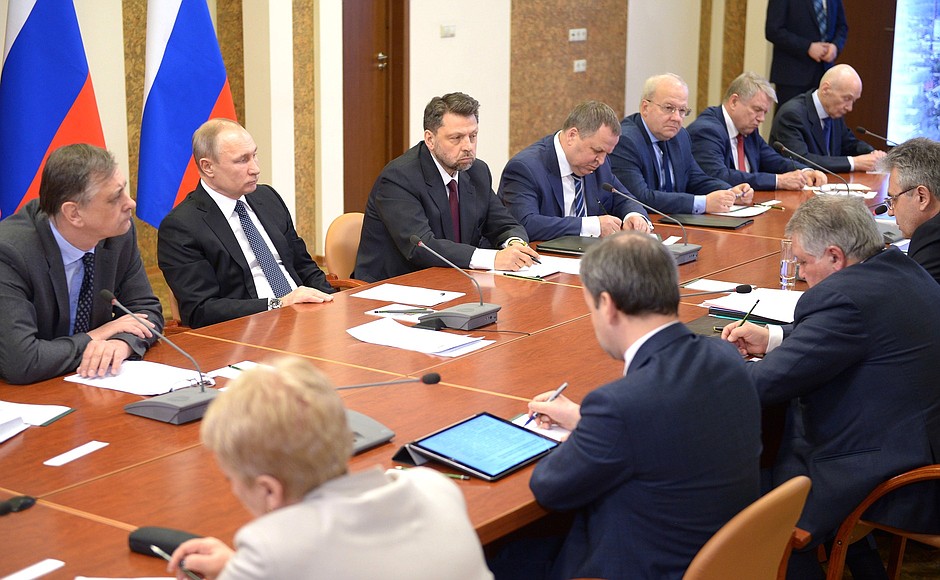
We propose three such projects. We have coordinated them with Mr Trutnev and discussed them at the Academy of Sciences and also with Mr Kovalchuk for the past few months. First, we propose creating a pilot nuclear medicine centre.
Second, a comprehensive project for the development of deep-water resources in the Pacific Ocean. And third, building a synchrotron on Russky Island. Mr Kovalchuk talked a little about this today. The regional authorities have supported these proposals and are ready to co-finance these projects.
A research and technology development programme for Crimea deserves special mention. Crimea had not received the necessary resources for this kind of development from the Ukrainian authorities for a long time, yet it has preserved a major research community. Moreover, the support Crimean scientists have received from Russia has given them the necessary incentive. We must support them.
The Russian Academy of Sciences is mainstreaming the Crimean projects that include both fundamental research and practical projects for technological, socioeconomic and cultural development. These projects include the search for water resources, offshore development, ecology and the creation of the Gate of Crimea research, historical and cultural cluster in Kerch.
Mr President, I would like to thank you for your assistance with these pilot projects. There will be many other projects, including the development of alternative energy sources in Crimea, a health resort centre for children in Yalta, and the construction of a Crimean Technology Valley. We hope that you will continue to support these projects.
A very important issue in the country’s spatial development is supplying resources to researchers and scientists in the regions. Pursuant to the May Executive Orders, in 2018 salaries in research and science have been raised to 200 percent of the regional average. This is, of course, an important and long-awaited measure in itself. However, as I reported before, the strict correlation between the scientists’ pay level and the regional average has resulted in a wide discrepancy between the incomes of the scientists who are working in similar research and who are equally recognised in the scientific community. Obviously, this situation could cause the additional migration of scientists to the capital centres and the weakening of regional intellectual resources, which we cannot allow.
I just want to remind everyone here that in the past, wages in the regions were intentionally slightly higher than in Moscow, in order to support regional development. There were regional coefficients. We believe that this gap needs to be closed as soon as possible. The absolute majority of scientists believe that researchers in federal institutions must receive equal pay for equal quality and performance. A slight difference is fair based on the consumer basket in specific regions.
We must continue to improve the social status of our researchers, designers and engineers, who are moving our science forward and making genuine breakthroughs.
I think this can be achieved in several ways. First, by allocating more funding for pay increases as part of state-ordered research. We all believe that the economy will grow and that this money will mainly be generated by the regions. Second, by redistributing state-ordered research based on performance and quality, something we are currently pursuing with the Federal Agency for Scientific Organisations. Finally, some projects and tenders supported by our foundations, the Russian Foundation for Basic Research and the Russian Science Foundation could support specific large initiatives in the regions.
Now, it is clear that it is necessary to negotiate with large companies – and we are also taking this on. The funds these companies allocate for applied science should be distributed to the regions that require support.
The Russian Academy of Sciences, for its part, will do its best to discover new and the most promising projects for the spatial, scientific and technological development of the country, provide a scientific basis and ensure that these projects are implemented and supplied with necessary resources.
Thank you.
Vladimir Putin: Thank you.
Mr Kovalchuk, is there anything to add?
President of the National Research Centre Kurchatov Institute Mikhail Kovalchuk: First of all, I would like to thank you, Mr President, and the Academy’s leadership for joining us on this important day for the Kurchatov Institute. This is an honour for us, and it is important. Thank you very much. This is the first point.
Second. I would say that our joint meeting – the leadership of the Kurchatov Institute and the Presidium of the Russian Academy of Sciences – is also a landmark event, because in fact there is a chance to merge these two potentials – the most significant in the country. And that is how it should be really. There has never been any controversy between us.
Today there was quite a big coincidence. I’ll let you in on a little secret. We discovered that we have both prepared gifts for each other. Our gift is a portrait of Anatoly Alexandrov who was the Kurchatov Institute director and the president of the Academy of Sciences – and they also brought Alexandrov’s portrait.
We take “our Christ to meet their Mohammed.” That is, it turns out that we have the same way of thinking, which is very important. I said this jokingly, but it actually says a lot. We grow from the same root system. The Kurchatov Institute – you all know, we have been working for the country and the world for 75 years – originated from an academic institute, after one lab split from the Leningrad Physico-Technical Institute. I mean, this root system is the academy. The Kurchatov Institute originated because ideas, research and people were concentrated in the academy. And then, the Kurchatov Institute in turn fertilized the academy, even giving it a president.
So, I would like to say, I think that our reunion today (I hope that you will approve, and that we will sign the agreement officially at the end), I think it is a symbolic step in raising our science, our scientific environment to a fundamentally new level. We do not have any controversy, but we do have a foundation for unity. Mr Sergeyev has cited many examples here.
It is actually quite obvious that your initiative to support the development of mega-science will involve great projects. They make us attractive to the world; they make us significant when it comes to joining foreign projects. We actually have an association we have created together with the Academy – we created it many years ago – which unites academic institutes and universities. We have a separate association of universities working with mega installations. We have a core. And if you support the idea that I am proposing together with Mr Sergeyev – to build another synchrotron in the Far East – then we will have an absolutely harmonious structure throughout the country. It will lead to the emergence of centres of excellence that will attract people – both Russians and foreigners. In this sense, this is one single project.
The network of nuclear medical centres is the second project.
Then we also talk about the logistics corridors, but I would like to say that there is one more important thing left. You talked about Crimea, the Far East, all things deep-sea. And now, as you instructed, we are working on deep submersibles. You have submerged before, in the south, and in the Baltic Sea, too. Now, together with Gazprom and the Russian Geographical Society, we are developing these deep submersibles, and I think they will be applicable in every area, which you talked about.
Moreover, in addition to everything you have just said, there is one more thing. Since our fleet, both civil and military, is actively developing, there are plenty of interesting things, nature-like technologies, which are currently being developed; we have enormous potential. For example, one such place is in the Far East, in the Pacific Ocean.
The second thing. Russia has Kaliningrad. The Baltic Sea, too – the entire Northwestern Federal District. And Arkhangelsk, and Leningrad, and Severomorsk as well. Furthermore, we also have Crimea; the academy has a base in Gelendzhik, plus the Ministry of Industry’s base, and Crimea, too. This means we can establish climatic (let us call them that for the sake of discussion) stations. They already exist, but we can bring them together into a network under the auspices of the Russian Academy of Sciences and the Kurchatov Institute and initiate comprehensive research there.
Today, when we talk about nature-like technology, we must pay special attention to what is called biomineralisation. Here is a simple example. Take, for instance, starfish or sea urchins – it actually is a kind of protein, which hardens in order to form a shell, which can withstand tremendous pressure. These are natural materials, which are formed from, roughly speaking, proteins and polymers, and later turn into ultrahard materials, and so forth. So, the phenomenon of biomineralisation in only studied in two or three places in the world, and one of these places is located here, in Russia – I am talking about the Far East. And if we consider our location and our access to the seas, we can extend biomineralisation, which can become a new leap in nature-like technology, to all these seas. Plus there already are climatic studies on materials; there is a very good centre, too. I believe that under the auspices of the Russian Academy of Sciences, and I hope that the Kurchatov Institute will gladly participate in this, too, we can recreate and formalise this network.
There is one more important thing. The Kurchatov Institute is using a great number of mega installations. In this sense, they are available for use by the Academy. We signed the papers a while back, this took place. I think that we can create a high-quality movement like this right now.
Thank you.
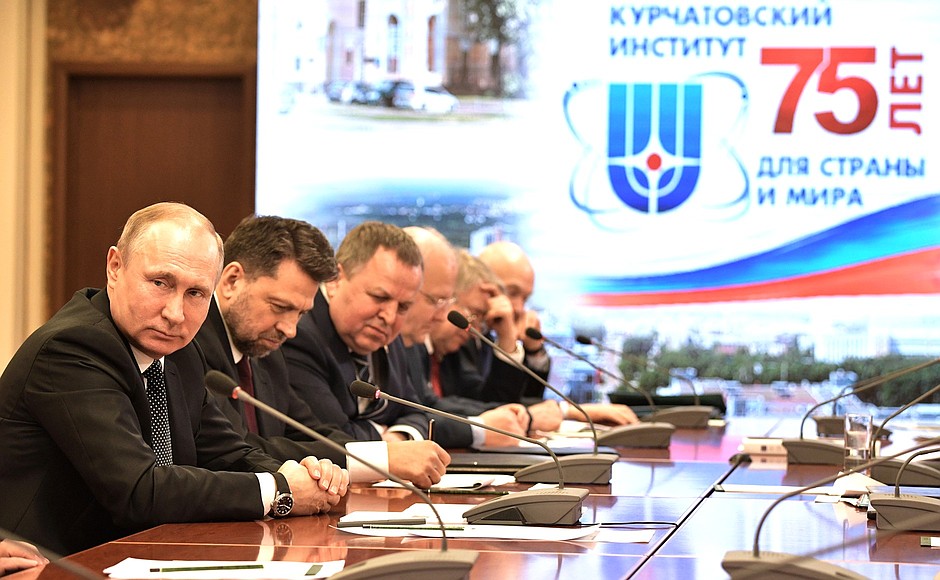
Vladimir Putin: Thank you.
Colleagues, does anyone want to add anything?
Vice President of the Russian Academy of Sciences Andrei Adrianov: To add to my colleagues’ statements, I would like to say a few words about the creation of attractive areas in Russia’s regions, primarily in the Russian Far East. Mr President, several major projects have already been implemented, with your support, in the Far East. Some projects are now being planned, I will not talk about this international collective use centre, but it calls for creating a synchrotron system. Indeed, the Kurchatov Institute operates the main unit, and there is another one at the Siberian Branch of the Russian Academy of Sciences. If Vladivostok receives its own synchrotron, it would greatly expedite the development of science as an ambitious multi-disciplinary area in the Far East.
A few words about the deep-sea project that was mentioned: this Russian Academy of Sciences’ initiative could unite many Russian institutes. As the latest research, including projects with Russian involvement, shows, the ocean’s depths conceal tremendous biological resources and great biodiversity. In fact, we had not suspected this before. Today, our neighbours in the Asia-Pacific region, including Taiwan, China and the Republic of Korea, are building their own fleets and special-purpose ships for deep-sea submersibles.
As you know, the shelf has been divided, and now we should expect attempts to demarcate deep-sea sectors of the world’s oceans. This is the largest habitat in the world with the greatest concentrations of biological materials. This is not just reserve biological resources for future generations. Today, these deep-sea resources provide us with unique biologically active compounds for developing new types of medications, including those for treating cancer, and new-generation antibiotics. At the same time, antibiotics made from “land-based” feedstock are no longer as effective. A good fleet of self-contained deep-sea robotic submersibles is now deployed in the Far East, and an experimental facility for manufacturing these submersibles has even been established there.
We have a good fleet of remote-controlled submersibles. We and our foreign partners have already become involved in this area. If we continue to expand this programme, the creation of a vessel for transporting deep-sea submersibles in the Pacific would, of course, greatly spur the programme. Thus, we would never lose our leading position in this region.
We hold a strong position today. We occupy at least one leading position in the Pacific theatre. At least. Indeed, these discoveries can also spur biomimetic research, as mentioned by Mr Kovalchuk. This implies new materials and new medications from the ocean’s depths. And we have also discussed this with the Federal Agency for Fishery. They are interested in developing technology for using deep-sea biological resources in the near future. This interesting project would help all of us work together.
This is happening even as interest in deep-water research in the international scientific community is growing. So, if you supported the creation of a synchrotron centre in Vladivostok… A centre of radiation medicine in the Far Eastern Federal University is yet another project that will get off the ground soon, this is also extremely important because we have 30,000 registered cancer patients in Primorye Territory. About 7,000 new cancer patients are diagnosed every year, and the creation of such a centre on Russky Island would enable at least 1,200 patients to get high-tech care.
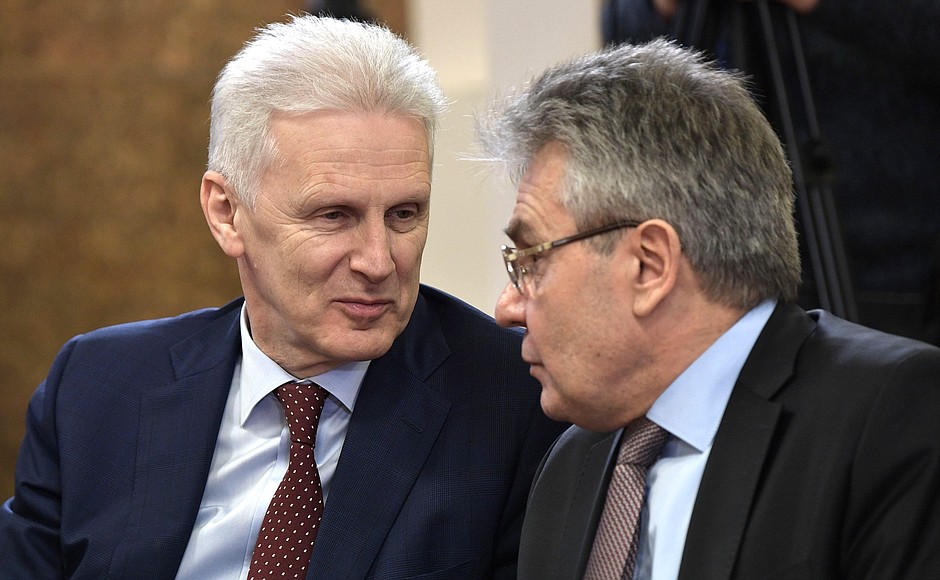
These three projects indicated by Mr Sergeyev, the synchrotron, radiation medicine centre as well as the deep-water project, would be very interesting for us in the Far East.
Vladimir Putin: Thank you. Colleagues, over to you.
Vice President of the Russian Academy of Sciences Yuri Balega: Mr President, under the Strategy of Scientific and Technological Development of our country, the funds for science are to grow two percent by the year 2035. We believe for our part that if we are to overcome the technological lag, it would make more sense to achieve the 2 percent level by 2024 (which is feasible) and at the same time retain the funding of fundamental research in the spending structure. Fundamental science would be funded to the tune of 0.35 percent of the GDP.
We link the solution of this task with the improvement of the technological base of science. We have some problems here. While the funding of research in nuclear physics is considerable (international mega-projects and projects in this country), things are not as well in other research areas.
I have worked for 23 years in the Caucasus as the director of an observatory with a telescope built in St.Petersburg (former Leningrad) at the Leningrad Optical-Mechanics Association. It was the biggest telescope in the world, but that was back in the early 1970s, half a century ago. Since then not a single major astronomical instrument (truly big instrument) has been constructed.
The world sees enormous breakthroughs in this field and it would be great to invest in this sphere, like in other research fields. We believe it would be realistic to renew research equipment in this country by some 50 percent by 2024. To this end between 5 and 7 billion rubles need to be invested every year in order to renew much of our scientific equipment and achieve a decent level of research. We are ready to work out a special programme of modernisation of our stock of research equipment. We’ll try.
Vladimir Putin: As regards overall spending on science, everything we have been speaking about, and the plans that we have – we are designing them proceeding from economic development forecast.
Yuri Balega: It’s not all that easy.
Vladimir Putin: Yes. But things keep changing, so we always bear in mind that we can add something in the breakthrough, vital areas of the country’s development depending on the situation concerning the world economy as well as the Russian economy. Of course science overall, fundamental science is one of our priorities. So, give us your proposals so that we can take them into account in our joint work. Is that all right?
By creating a network of federal universities, we have strengthened not only our education system but also our research sphere as a whole. Measures to boost the development of science across Russia were outlined. We decided to create mega-science centres in Novosibirsk and in Protvino in the Moscow Region.
Now over to you.
Vice President of the Russian Academy of Sciences Valentin Parmon: Mr. President,
In Siberia, we have worked intensively to streamline the rapid development of the Novosibirsk Science Centre and the Tomsk Science Centre. This was done in line with our conversations when you came to Novosibirsk and especially after March 1. The Siberian Branch, FASO and regional leaders elaborated this concept. We are focusing on the development of pure science and the creation of a powerful technological foundation for Russia. And we are absolutely confident that, given the Government’s support, and we are expecting such support, it will take us ten years to establish… We do not want to call this a “Silicon valley,” a “Golden Valley” exists in Novosibirsk’s Akademgorodok, but we guarantee that Siberia will receive a “Silicon Taiga.” At any rate, the first facilities are to be established in the next 3–5 years.
What will seriously hamper our efforts, and what help do we need, apart from financial and administrative support? Novosibirsk State University ranks among the top three to five universities, and it trains skilled personnel. We would like this university to work more effectively for the Siberian region, and we would like Novosibirsk State University to have the same status as Lomonosov Moscow State University and St. Petersburg State University. It appears that the university deserves this status, and, if the relevant proposals are examined, the people of Siberia guarantee that everything will be recouped 100 times over, including the best-trained personnel.
Thank you.
Vladimir Putin: Thank you.
We will not resolve this issue today, but let us take a closer look, OK?
You have the floor, please.
Vice President of the Russian Academy of Sciences Valery Charushin: Mr. President, colleagues,
We have already noted the importance of regional scientific development. I would like to draw attention to the Ural region where very interesting partner-like relations between the Academy’s institutes and Ural Federal University have long been established. In the past few years, we have been working with Mikhail Kotyukov [Head of the Federal Agency for Scientific Organisations (FASO)], to establish joint laboratories, and this practice has won a reputation for itself.
However, I would like to draw attention to another important aspect, without which it would be impossible to develop regional science. I am talking about housing for research associates. In the past five years, the Ural region has witnessed major positive changes, and we acted together with the Federal Agency. We have issued hundreds of certificates to early-career scientists, and the Federal Agency has received hundreds of flats after the implementation of investment projects.
We have been carrying out a major construction project in the Akademichesky district for the past ten years. Last year alone, we set aside 300 federal properties, including 100 for the Federal Agency, and 200 for other federal agencies, including the National Guard of Russia, Investigative Committee divisions and prosecutors’ offices. It appears that we are doing a good job. But we do not have the required resources today. The Academy of Sciences has now been deprived of this non-core function, which was relegated to FASO, the body that controls our administrative directorate. And now, we need support from the region and probably from FASO because we find this task to be rather burdensome.
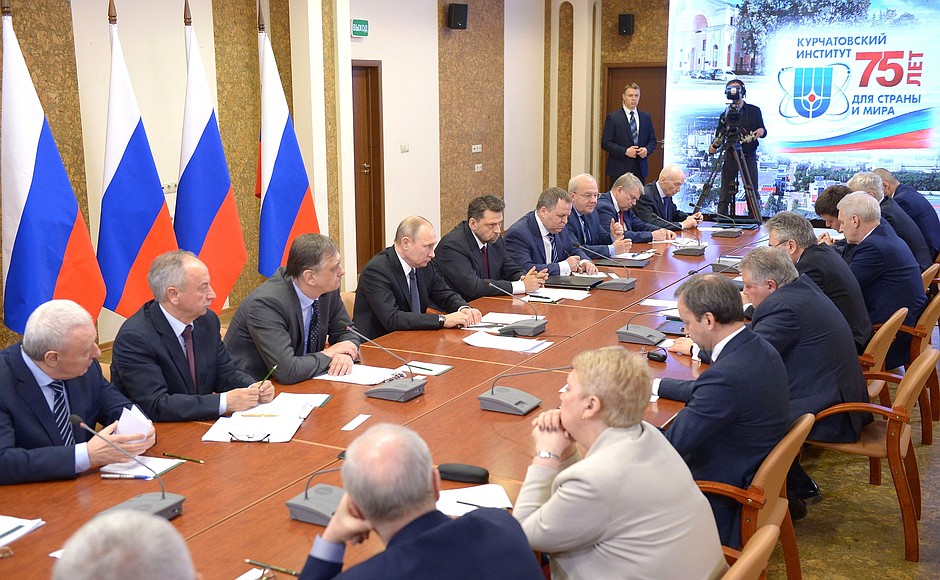
When everything proceeded smoothly, we generally had no problems, but in the past few years, an investor went bankrupt and difficulties began to snowball. Anyway, this could be a long story.
I am simply asking for effective assistance. Maybe, the Governor who knows these issues can help. We are implementing a multi-billion-rouble project that would profit us, the university and federal-agency employees. This is my request.
Vladimir Putin: Please.
Deputy Prime Minister Arkady Dvorkovich: We have a mechanism for resolving this issue via the Housing Mortgage Agency. I will link up with our colleagues, so that they can resolve this with the Governor.
Vladimir Putin: Just formulate the issue and give me a document. I will forward it to my colleagues, and we will start working. It goes without saying that this is the most important aspect. I have already said a few words about the social wellbeing of scientists; this concerns their wages and the provision of housing. The Kurchatov Institute started with 20 kilogrammes of uranium, two grammes of radium and only ten flats. Although Kurchatov had his own office on Lubyanka Square, they allotted only ten flats.
Please formulate all these issues, and we will address them.
Vice President of the Russian Academy of Sciences Vladimir Chekhonin: Mr President, colleagues,
I am in charge of fundamental medicine at the Academy of Sciences’ presidium, so I will only focus on this area.
Mr Sergeyev has already said here that the nuclear projects that we hope to undertake with the Kurchatov Centre are extremely promising. However, your Address to the Federal Assembly laid special emphasis on life expectancy. It should grow, in essence, up to 78 years within six years. This is a super-task, Mr President. We are aware of its complexity, yet it is solvable. It can be resolved through cooperation with the Health Ministry, with Russian Academy of Sciences institutions, FASO, with executive bodies at all levels. Our analysis indicates that life expectancy in Russia is 35 percent contingent on the GDP, 35 percent on the people’s lifestyle and 30 percent on healthcare funding.
The top priorities in public health care at the current stage must be the underperforming categories of the population such as men and children under the age of 14, since these are the categories that underperform most.
Spatial development programme, about which I also spoke in the Presidential Address, is designed to provide conditions for the people’s creative endeavours and to encourage them to form new research communities, so that conditions for self-realisation, interesting jobs and a full-bodied life will be available across Russia.
We have achieved a lot in terms of establishing a healthy life style thanks to your initiatives in the previous eight years. However, a breakthrough in this field would require setting up an inter-agency council, probably, with a respective deputy Prime Minister to head it. The Russian Academy of Sciences in this respect is ready to engage all available resources in diagnostics, primarily of therapeutical diseases and socially significant diseases such as cardio-vascular, oncological and infectious diseases, which mainly account for the mortality rate in our country.
I think we will be able to establish momentous interaction, broad cooperation with the Kurchatov Centre because fundamental science is being developed in enormous strides here.
We believe, Mr. President, that the Health Minister jointly with the Russian Academy of Sciences should report to you on a quarterly basis on the aspects related to the programmes and the reaching of the targeted goals in this respect. This is crucial.
Vladimir Putin: This matter also needs thinking over and articulating. We have a number of councils, however, you are right, this is one of the major spheres of our job. So let us consider at which level and how we should set up this mechanism. Generally speaking I have nothing against this.
Vice President of the Russian Academy of Sciences Alexei Khokhlov: Mr President, colleagues,
I would like to say a few words about human resources in the Russian research community.
Considerable assistance is being provided to young researchers aged under 35 years, thanks to the presidential programme of research projects that was proposed at the President’s meeting with scientists who received mega-grants for scientific research. Overall, they receive different types of assistance in the form of grants.
Vladimir Putin: But the volume of such assistance may vary.
Alexei Khokhlov: Yes, it may vary. But scientists aged between 35 and 50 do not receive this type of assistance. I can tell you from my own experience and the experience of my colleagues that the most productive period intellectually is between the ages of 35 and 50. This is the time when researchers have learned all they could from their teachers and can implement their own projects. Regrettably, these people do not always receive an opportunity to implement their own projects or create their own laboratories.
I believe it could be reasonable to develop a programme for supporting the establishment of new independent laboratories in various places, including in the regions. It is a fact that those who accept positions in the regions, where they create new laboratories, are in the worst situation, because they have limited access to information resources, research equipment and devices, and the like. Therefore, I believe this programme could become a good addition to the presidential programme of research projects. At the regional level, it could increase connectivity in the Russian research environment.
I believe that the Russian Academy of Sciences could effectively contribute to these efforts. It is a programme we can easily implement now, or at least contribute to its implementation if the Government takes on this crucial programme.
Vladimir Putin: We created a system of mega-grants and other grants long ago, and it has been working quite well. As for young researchers, our reasoning was, first, to keep young researchers in Russia, second, to create conditions for them, and third, we thought that this is very important because of their vulnerability in terms of income and professional opportunities. We believed that we should create special conditions for them, so that they gain a footing in their research preferences and also financially. However, nothing is perfect, and new questions arise in the process of implementing approved programmes. Let us discuss all this together.
You have the floor now.
Presidential Aide Andrei Fursenko: Just for your information, a targeted programme is used to support young specialists, it is an overall sum amounting to under one percent of the budget funds. It is a matter of targeted issues. All the other budget money is allocated largely on a competitive basis, and there are no age limits there. It is at the discretion of each institute, laboratory and the Academy in general to identify their priorities.
Vladimir Putin: It is a matter of funding research. Our colleague was speaking about those percentage points, this is what it is about. Now it is clear.
Please, go ahead.
Vice President of the Russian Academy of Sciences Nikolai Makarov: Mr President, colleagues,
I would like to address the issue of cultural heritage preservation, although it may seem somewhat odd for the Kurchatov Institute. Yet it is an important issue because you spoke in your Address to the Federal Assembly about the significance of preserving the faces of our cities, about the importance of creating new museum sites in the regions, and we should certainly rely on our heritage as we develop the spatial structures of Russia, and re-develop our country.
This work mostly goes unnoticed, but many archaeological digs at new development sites are conducted by our archaeological institutes, and whatever was discovered in Crimea in the past years was for the most part found at new construction sites. They are brilliant achievements and outstanding finds, made possible thanks to the legislative provision that requires a preliminary historical and cultural analysis of the territory prior to large-scale construction.
There are proposals to scrap this provision from the legislation. They have been voiced by the Ministry of Construction and are to be submitted to the State Duma shortly as a draft law, as amendments.
On behalf of my colleagues – historians and philologists who are very concerned over this potential development – I would like to ask you to keep the provision requiring historical and cultural expert assessment because it is an effective tool to ensure the preservation of cultural heritage. Meanwhile, our Academy is ready to submit proposals on how to make the procedure more efficient, to streamline it, to possibly speed it up but not at the cost of heritage preservation.
Mega projects in the Humanities face a lot of difficulties, however, setting up a museum and research cluster in Kerch is an ideal format for a mega project. Because a “gate” to Crimea, the new transport infrastructure is being established on the territory of the capital of the Bosporus Kingdom, it is Kerch that emerged on the site of Panticapeaon. It is the territory of grand Scythian and Greek mounds, the treasures of which made up the collections of the Hermitage and the Historical Museum. The place has much to display.
And this project could also blend a new museum and an academic laboratory on in-depth inter-disciplinary study of antiquities with international participation. And it will also rectify the socioeconomic situation in Kerch, which is now an industrial town concealing its historical face. So this could become a blend of academic science together with practical improvement of the territory. I would like to ask you to support this project.
Vladimir Putin: Submit the project and we will look into it separately. This undoubtedly sounds interesting and important. As to amendments to the law, I think the second part of the question you raised is crucial. Concerning the activities that should be acceptable in terms of time, cost, so that the activities (which are apparently utterly important) do not turn into a quasi tax on construction work. But I completely see eye to eye with you that the expert assessment should remain.
Let us move along.
Vice President of the Russian Academy of Sciences Valery Bondur: Mr President, colleagues,
I would like to go back to spatial connectedness. I would like to underline a peculiarity of our country. It has a land border of 61,000 kilometres whereas maritime border space amounts to 8,600 kilometres. If we all line up along the border, there will be gaps between us. Ten Chinese and five to six Europeans and Americans will be facing us. It means we have to apply different means in order to…
Vladimir Putin: They will not face us, do not worry about that.
Valery Bondur: What means can be suggested to solve the problem? We have a peculiar country, with many regions hardly accessible because of poor weather conditions. We have polar regions and the polar night. And there is a method of using modern promising techniques of remote probing and creating spatially distributed monitoring systems including space monitoring. That is, today’s space ships, unmanned probes and other devices generate huge streams of information in different spectral bands with different devices which use electromagnetic waves, magnetic fields, gravitational fields, particle streams, which makes up a good subject to develop with the Kurchatov Institute.
What are the main trends today? One trend is creating multi-satellite small-scale systems; we are talking about satellites like SkySat and CubeSat, the smaller ones. They are not costly, but you have to launch a lot of them. As Google stated today, a new system has been created that updates its data on a daily basis. So far, it is for medium resolution only, but soon one-metre resolution will become available, and our country could take a big step forward. The next trend is, importantly, radar systems. Our country was the first to launch a radar satellite into orbit, but, unfortunately, we have no active radar satellites today. The first satellite was designed for marine space reconnaissance and target designation; a 5.5-kilowatt nuclear reactor was used to power it. Together with our organisation, where I used to work, researchers from the Kurchatov Institute worked on creating such a system.
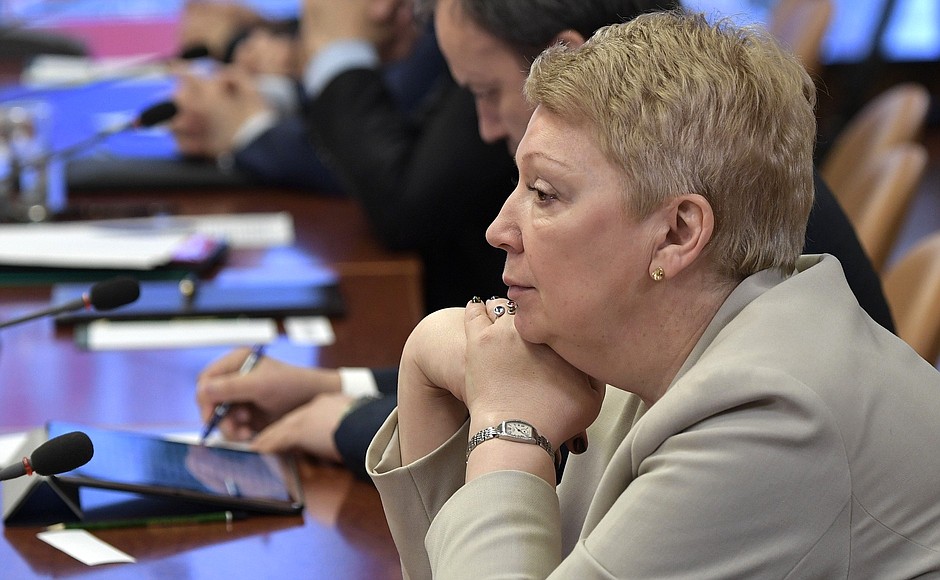
Today, many European countries, and even Korea, have their own radar systems. If we use our country’s experience in creating small-scale radar facilities with a synthetic aperture, which has already been tested with unmanned aerial vehicles, we will be able to form a multi-satellite group based on such radar systems. They are all weather, which means that clouds are not a problem. Seventy percent of the time, our country is covered with clouds. Everyone knows this: today, and yesterday, too, the weather was fine, but before this, we hadn’t seen the sun for almost two months.
What kinds of problems do we face here? First, the enormous amounts of data that we receive from satellites. Today, it is Petabytes; tomorrow, or in the near future, it will be Exabytes. We need special methods and tools to process this amount of data (which is big data): I am talking about computational tools, algorithms, parallel algorithms, cloud systems, methods for database creation.
And here, we have good ideas, and projects, too, which are currently being implemented at the Ministry of Education and Science and the Kurchatov Institute. The Russian Academy of Sciences has similar concepts, too. What is the most important thing today? Not only to receive this enormous amount of data, but to update it every day, several times a day, even, with a resolution of several metres or even better – we need to process and deliver this data to users, and do it quickly.
In order to do this, we need very specific databases, which will allow us to process all this data and present it in 4D using GIS-systems to create the geospatial data that will be of use to not only the regions, but also to the federal authorities and various branches of the economy as well – I am talking about natural resources, agriculture (and I think more will be said about that later), the security of the country, for preventing technogenic and natural disasters, monitoring the environmental status of the territory, and so forth.
That is the kind of project I believe our country can easily implement, meaning that we already have the technical foundation. But this requires certain organisational activities. And we would like you to support this programme.
Vladimir Putin: I must see this concept in a full representation. Agreed? We need to discuss this between departments, too.
Arkady Dvorkovich: We started discussing this within the framework of the Digital Economy programme. Together with our colleagues, we will be able to submit our proposals for your consideration soon.
Vladimir Putin: Good.
Vice President of the Russian Academy of Sciences Irina Donnik: May I?
Vladimir Putin: Of course.
Irina Donnik: I am responsible for the agricultural sector, therefore I will be speaking about our daily bread.
Mr President, colleagues,
Mr Sergeyev spoke about Crimea, where the main priority of the Agriculture Ministry can be implemented, that is, selective breeding and seed generation programmes, including sugar beet seed generation. According to the approved indicators, import substitution should reach 20 percent by 2025. However, our scientists have devised a technology under which Crimea’s unique environmental and weather conditions can be used to breed these seeds, Russian seeds, in half the time, by reducing the generation process from two years to 12 months. This would allow us to reach 40 percent in seed import substitution within three years. But the success of this project depends on water supply for irrigation.
Our scientists can and are working on a technology for the use of weakly salinized surface water and wastewater for irrigation. It is definitely not a cheap project. Its cost has been estimated at some 700 million rubles. But its implementation would enable us, first, to implement the plant-breeding programme, and second, to create a source of stable income for Crimea. We hope you will support our project despite the costs involved.
In general, I would like to say the following about Crimea. There are three research institutes in our sphere there: the Magarach Institute of Vine-Growing and Wine-Making, the Institute of Agriculture and the Nikita Botanical Gardens. We strongly hope they will preserve their unique identities and will not be deformed during the merger, because they have different goals and spheres of operation. We hope very much for your support.
Vladimir Putin: Are there merger plans?
Irina Donnik: Yes, mergers are a permanent trend, or merger ideas are proposed. Mr Kotyukov is smiling, but we have discussed this issue with him many times, and we have prevented the proposed mergers so far, because Magarach is a unique institution that must be preserved in its current form. These institutions must not be merged. It is my personal opinion and also the opinion of our colleagues and the department of agricultural sciences.
And there is another matter of major concern that I would like to speak about. Some people may see this as a minor thing, but we believe it concerns the country’s strategic security, biosecurity. I am referring to veterinary science.
We face the ever-present danger of animal and plant infections. And we need to provide regular and major scientific support to every veterinary problem. At least this is how it was done in the past, even though it has become inappropriate to bring this up. Regrettably, the number of research institutions concerned with this problem has decreased several-fold. There are only four such institutes left and they are to be found in Moscow, the Moscow Region and there is also one in Voronezh. All the others have been reformed or merged with agrarian centres. Practice shows that a change in the specialisation of such institutes leads to a decrease in the number of veterinary subjects and scientific schools.
In the past 10 to 15 years, 64 scientific schools have disappeared. We believe that this testifies to the destruction of Russian veterinary science, which used to be very strong. But we still need to address these matters, especially in light of the tough requirements needed to train veterinary specialists at universities. The main complaint concerns a lack of practical training, which we cannot provide.

We propose setting up veterinary research centres in Siberia, the Urals, the Far East, as well as in southern and central Russia. The Russian Academy of Sciences, the remaining veterinary research departments at universities and business associations would coordinate the operations of these centres in the field of veterinary practice. Graduates could be involved in this work.
Vladimir Putin: Am I right in thinking that currently veterinary control is the responsibility of the regions?
Arkady Dvorkovich: Yes, for now, but we have issued instructions at the forum in Krasnodar to develop proposals on the federal consolidation of this sphere.
Vladimir Putin: It happened when we delegated veterinary control to the regions, which led to the appearance of this problem.
Colleagues at the Krasnodar forum proposed reinstating federal control. We will do this, and the programme on veterinary control you have proposed will be pertinent.
Irina Donnik: Thank you. Otherwise we will react to epidemics instead of preventing them. Thank you.
Vladimir Putin: Please, formulate your proposals, because the country needs them, and our Crimean colleagues will implement them.
Mr Fursenko, please monitor this matter and report back to me on how it’s getting on.
Irina Donnik: Thank you.
Vladimir Putin: You have the floor.
Vice President of the Russian Academy of Sciences Valery Kozlov: Mr President, colleagues,
In his remarks Mr Sergeyev mentioned the draft federal law amending Federal Law No. 253 on the Russian Academy of Sciences that you, as President, have submitted to the State Duma. You have designated me as your envoy in relation to the adoption of this draft law. For this reason, allow me to provide a brief update.
For us and for everyone who expressed their views on this matter, including in the State Duma, this federal law is extremely important. It is viewed as a step in the right direction that follows up on the reform to streamline relations in the area of fundamental research.
As you probably well know, the draft law already passed the first reading in the State Duma, and was supported unanimously. Everyone agreed that it was heading in the right direction. Preparing for the second reading, the only thing I asked members of the State Duma was not to try to amend, improve or change the text too much. There is always an urge to do just this, but, honestly speaking, we need to refrain from pushing too hard and follow what the mathematicians call a successive approximation procedure. This law is extremely important for us as well. Of course, it vests us with new authority across a broad range of areas, but we all understand that with it comes new responsibility for the Academy. How can all this be done effectively?
I would like to make two points here. The Academy of Sciences is charged with overseeing research and methodological work in all fields of research in the Russian Federation. This is not an easy task, to put it mildly. After all, this requires being completely immersed in this activity in order to be able to analyse, understand everything and issue recommendations, assessments and expert reviews.
It is obvious that this would be impossible without the involvement of research institutions that used to be part of the Academy. In this sphere, we definitely need to work together with the Federal Agency for Scientific Organisations in order to reach out to experts, our colleagues, working for Russia’s leading research and academic institutions.
There is also a question on a provision from Federal Law No. 253 whereby the Russian Academy of Sciences is entitled to do research on its own. However, there are currently no research fellows within the Academy. But the legal provision exists, and we must get to the bottom of this matter and develop an understanding of the subject.
I would like to quote a saying by Anton Chekov who famously said that if in the first act you have hung a pistol on the wall, in the final act it should be fired. So if we establish a norm of this kind, it means that we believe that such prospects exist, so the Academy and all of us must understand this.
Mr President, colleagues,
Looking at the situation in terms of legislation, we see that we must continue our efforts.
Mr Sergeyev has already reported on a project to streamline and enhance the legal status of the Russian Academy of Sciences. Today, we have the opportunity to congratulate our colleagues from the Kurchatov Institute on the occasion of its 75th anniversary. This is a remarkable event for all of us, including the Academy of Sciences. That said, in 2024, as Mr Balega already pointed out when he spoke about funding opportunities, we will be celebrating the 300th anniversary of the Academy of Sciences, which is a major landmark. It goes without saying that we would very much like to make sure that the Academy of Sciences is integrated into the legal framework.
Mr President, allow me to say something even my colleagues here may not know: up until 1998 the Russian Academy of Sciences was not a legal entity. It was registered as the country’s supreme research institution without being an independent legal entity. And we managed to get along quite well (Laughter in the audience). It seems though that all the problems we have followed our decision to register as a legal entity.
Why am I bringing this up? What I would really like to say is that the legal status of the Russian Academy of Sciences, the country’s oldest and most unique research institution, is not only challenging but also very captivating, to be honest, including for our colleagues who specialise in law who could take up all these matters.
Vladimir Putin: Thank you.
Regarding the provision on independent research by the academy, this was the proposal of the academy. We took it into consideration and decided to accommodate this request. It is clear however that research is mostly carried out by academic institutes, not the academy. Nevertheless, if the academy wanted to have this option in the law, I did not oppose it. Of course, we can think of how this legal provision can be implemented. This is understandable. If you see any threats during the review of the draft law by the State Duma, come to me directly, since you are my direct envoy. You can also work with Mr Sergeyev and Mr Fursenko. We will try to come up with a response without delay.
Colleagues, Mr Sergeyev and Mr Kovalchuk wanted to sign a document. We are happy to provide you with a wonderful opportunity to sign a cooperation agreement between the institute and the Academy of Sciences on the occasion of the anniversary of the Kurchatov Institute.
Congratulations!
